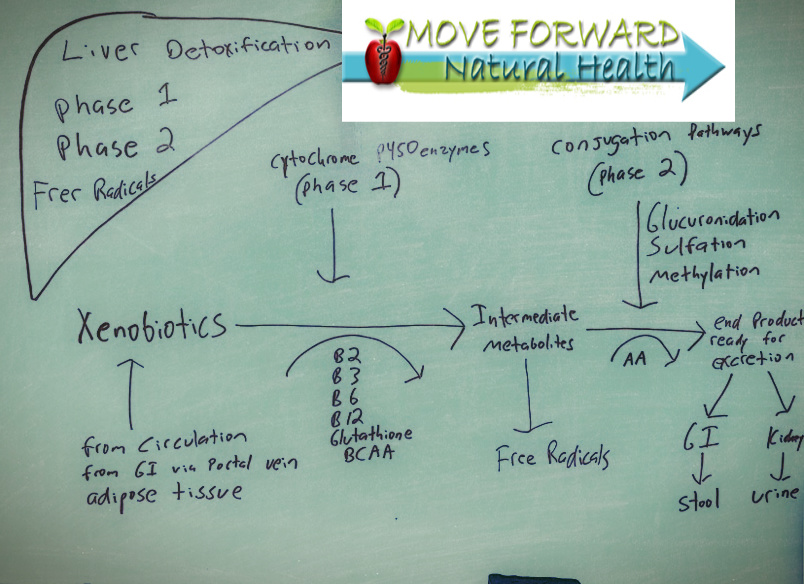How Does Detoxification Work?
The human body is equipped with several natural detoxification systems that work together to neutralize, transform, and eliminate harmful substances. These systems play a vital role in maintaining good health and preventing the accumulation of toxins. The liver is the primary organ responsible for detoxification, converting harmful substances into less toxic compounds and preparing them for elimination from the body. The liver performs this function through two main phases, Phase I and Phase II detoxification, which involve a series of complex enzymatic reactions. There is also a third phase that is not as widely recognized but is still important for the detoxification process.
The major mechanisms involved include the Cytochrome P450 enzymes (phase 1) which converts lipophilic (fat-loving) toxins into more hydrophilic (water-loving) intermediates. This process is then followed by a series of conjugation enzymes (phase 2) which attach certain molecules to the intermediates resulting in excretion from the body.
Advanced Understanding of Liver Detoxification
Feel free to skip to the quick summary at the bottom of the page if you don’t want to get into the specific physiology and nutritional biochemistry involved.
Phase 1 Detoxification
Phase 1 detoxification serves as the initial step in our body’s natural process of neutralizing and eliminating harmful substances. This phase is initiated by cytochrome P450 enzymes, which are responsible for oxidizing a wide variety of toxic substances. The primary goal of Phase 1 detoxification is to convert lipophilic (fat-soluble) substances into hydrophilic (water-soluble) substances, enabling easier excretion from the body.
The primary objective of this phase is to modify the toxin’s structure. This involves oxidation, reduction, or hydrolysis reactions, depending on the xenobiotic’s structure. The main reactions involve the following groups:
- OH (Hydroxyl group)
- COOH (Carboxyl group)
- NH2 (Amino group)
During Phase 1 detoxification, the liver transforms a nonpolar, lipid-soluble toxin into a more polar and less lipid-soluble state (intermediary metabolites) using the reactions mentioned above. This transformation allows the pathway to proceed to the conjugation pathway (Phase 2).
Upon completion of Phase 1, the cytochrome P450 enzymatic reactions generate reactive oxygen species (ROS), which are oxygen-containing free radicals. Free radicals, atoms or molecules with one or more unpaired electrons, have high reactivity that can result in tissue damage. Incorporating antioxidants into the diet can help counteract oxidative stress.
Required Nutrients: Certain nutrients, including B vitamins, zinc, and magnesium, are required for proper cytochrome P450 enzyme activity. Antioxidants such as vitamins C and E, glutathione, and selenium can help to mitigate oxidative stress during phase 1 detoxification.

Phase 2 Detoxification
Phase 2 detoxification, also known as the conjugation phase, is the second step in our body’s natural process of neutralizing and eliminating harmful substances. This phase is initiated after Phase 1 detoxification has converted lipophilic (fat-soluble) substances into hydrophilic (water-soluble) intermediary metabolites. Phase 2 detoxification involves attaching these intermediary metabolites to specific molecules, like amino acids or other compounds, in a process called conjugation. This process makes the metabolites even more water-soluble, allowing them to be easily excreted from the body through urine or bile. The primary purpose of initiating Phase 2 detoxification is to ensure the safe and efficient removal of toxins and other harmful substances from the body, thereby reducing the potential damage they could cause to our cells and tissues. If phase 2 is inhibited these intermediates can damage proteins, lipids, and DNA.
Amino Acid Conjugation
Amino acid conjugation involves the binding of toxic substances to specific amino acids, such as glycine, taurine, and glutamine. This process increases the water solubility of the substance and enhances its elimination from the body. The amino acids used in this pathway are synthesized in the liver and require specific enzymes for conjugation to occur.
Methylation (CH3)
Methylation is another important conjugation pathway in liver detoxification. This pathway involves the addition of a methyl group (CH3) to a toxic substance, which increases its water solubility and promotes elimination from the body. This pathway is dependent on specific enzymes, such as methyltransferases, which require certain nutrients for proper function.
Acetylation (CH3-CO)
Acetylation is a conjugation pathway that involves the addition of an acetyl group (CH3-CO) to a toxic substance, which enhances its solubility and promotes excretion from the body. This pathway is also dependent on specific enzymes and nutrients, such as acetyl-CoA and N-acetyltransferase.
Glutathione Conjugation
Glutathione conjugation is a Phase 2 detoxification pathway that involves the binding of a toxic substance to glutathione, a tripeptide composed of cysteine, glycine, and glutamate. This pathway is one of the most important in liver detoxification, as glutathione is a key antioxidant and detoxifier in the body. Glutathione conjugation is dependent on specific enzymes, such as glutathione S-transferases, and requires certain nutrients for proper function.
Required Nutrients: Amino acids such as cysteine, glycine, and glutamine are necessary for the synthesis of glutathione, a key molecule in phase 2 detoxification. Amino acid conjugation requires adequate levels of glycine, taurine, and glutamine, while methylation requires nutrients such as L-methylfolate, vitamin B12, and methionine. Acetylation is dependent on acetyl-CoA and N-acetyltransferase, while glutathione conjugation requires adequate levels of glutathione, cysteine, and glycine. Other nutrients, including methionine, choline, and betaine, are also important for phase 2 detoxification.
Intermediate Phase Detoxification
The intermediate phase of detoxification serves as a bridge between Phase 1 and Phase 2 detoxification processes, ensuring a seamless transition and proper management of toxins in the body. During this phase, the body deals with the reactive oxygen species (ROS) and free radicals generated in Phase 1. These byproducts can potentially cause harm to cells and tissues if left unchecked. Antioxidants, such as glutathione, vitamin C, and vitamin E, play a crucial role in neutralizing these harmful substances, preventing cellular damage and oxidative stress. The intermediate phase also prepares the hydrophilic intermediary metabolites, produced in Phase 1, for the conjugation process in Phase 2. This phase ensures that the body effectively manages the detoxification process, protecting our cells and promoting overall health.
Required Nutrients: Nutrients that support phase 1 and phase 2 detoxification, such as antioxidants, amino acids, and B vitamins, are also important for the intermediate phase. The nutrient taurine has been shown to support the intermediate phase by stabilizing reactive intermediates.
Phase 3 Detoxification
Phase 3 detoxification, also known as the “antiporter phase,” relies on specific transport proteins called antiporters to facilitate toxin elimination at the cellular level, primarily in liver and intestinal cells. These antiporters are membrane transport proteins that exchange substances across the cell membrane in opposite directions, enabling the expulsion of modified and conjugated toxins from the cells while simultaneously importing essential molecules like glutathione.
Once toxins have been converted into water-soluble compounds during Phase 1 and further conjugated with other molecules in Phase 2, their elimination becomes more manageable. Phase 3 focuses on transporting these transformed substances out of the body through various pathways, including the liver, kidneys, intestines, lungs, and skin. The liver serves as the primary route for toxin elimination, as neutralized toxins are released into bile and subsequently excreted through the digestive system. Meanwhile, the kidneys aid in toxin removal via urine, and the lungs and skin eliminate volatile substances and toxins through exhaled air and sweat, respectively.
Required Nutrients: Nutrients such as magnesium, taurine, and amino acids like methionine and cysteine have been shown to support phase 3 detoxification by promoting bile flow and transport.
Quick Summary
The liver plays a crucial role in detoxification by breaking down and neutralizing harmful substances through a two-phase process: Phase 1 and Phase 2 detoxification. There is also a 3rd phase that is not as widely recognized but focuses on transporting these transformed substances out of the body.
Phase 1 detoxification involves a group of enzymes called cytochrome P450, which oxidize and convert toxic compounds into less harmful intermediates. These intermediates, however, can still be reactive and potentially harmful to the body.
Phase 2 detoxification, also known as the conjugation phase, further neutralizes these intermediates by attaching them to molecules, such as glutathione, sulfate, or amino acids. This process makes the toxins water-soluble, allowing them to be easily excreted from the body through urine or bile.
Supporting liver detoxification is essential for maintaining overall health, and can be achieved through a healthy lifestyle, proper nutrition, and reducing exposure to toxins.


